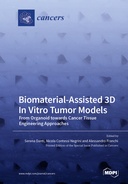Explore

Biomaterial-Assisted 3D In Vitro Tumor Models: From Organoid towards Cancer Tissue Engineering Approaches
0 Ungluers have
Faved this Work
Login to Fave
This reprint focuses on fundamental and applied research involving the combination of biomaterials and cancer cells to develop a three-dimensional (3D) tumor microenvironment in vitro, in which carcinogenesis mechanisms can be studied and therapies can be screened. Such models are becoming quite popular within the bioengineering community; thus, many technologies are being tested to obtain the best scaffold for each tumor. In any case, only a tight interaction of bioengineers with cancer biologists and oncologists can make such 3D models progress, with them finally reaching a clinical relevance. On the other hand, the medical community is approaching simpler 3D in vitro models not provided with sufficient extracellular matrix biomimicry, such as spheroids and organoids, which may not be self-exhaustive; therefore, cancer researchers could benefit from closer contact with bioengineers. The aim of this reprint is to help generate shared knowledge and promote strong interdisciplinary collaboration with the ultimate goal of contributing to the acceleration of the discovery and validation of more precise therapies to fight cancer.
This book is included in DOAB.
Why read this book? Have your say.
You must be logged in to comment.
Rights Information
Are you the author or publisher of this work? If so, you can claim it as yours by registering as an Unglue.it rights holder.Downloads
This work has been downloaded 89 times via unglue.it ebook links.
- 89 - pdf (CC BY) at Unglue.it.
Keywords
- 3D
- 3D bioprinting
- 3D cancer models
- 3D cell culture
- 3D culture
- 3D in vitro model
- 3D microfiber
- 3D modeling
- 3D printing
- 3D tumor model
- 3Rs
- A2780
- amoeboid cell migration
- Biology, Life Sciences
- Biomaterials
- bioprinting
- bone
- bone cancer
- bone matrix
- bone model
- brain cancer
- Breast cancer
- calcium phosphates
- Cancer
- Cancer cells
- cancer tissue engineering
- cell culture techniques
- cell lineage
- chemotherapy
- cisplatin
- clonal evolution
- colon cancer
- colorectal neoplasms
- degradation
- drug resistance
- durotaxis
- EGFR
- epithelial ovarian cancer
- epithelial-mesenchymal transition (EMT)
- Experimental models
- Extracellular matrix
- extracellular matrix (ECM)
- fused deposition modeling
- HIF-1a
- Hydrogels
- hypoxia
- immunotherapies
- in vitro model
- longitudinal imaging
- Mathematics & science
- Mechanical properties
- mesenchymal stromal cell
- metastasis
- Model
- n/a
- neoplasm recurrence
- organoids
- Orthopedics
- ovarian
- PANC-1
- Pancreatic Cancer
- pancreatic ductal adenocarcinoma
- patient-derived
- PDAC
- Personalised
- personalized therapy
- polyhydroxyalkanoates (PHAs)
- polymeric scaffolds
- polyurethane scaffolds
- primary cancer cells
- Pten
- radiation
- radioprotection
- Radiotherapy
- Reference, information & interdisciplinary subjects
- Research & information: general
- RHO
- rock
- scaffold
- scaffolds
- screening
- self-assembling peptides
- self-renewal
- SK-OV-3
- spheroids
- Technology, engineering, agriculture
- three-dimensional
- Tissue Engineering
- topotaxis
- trafficking
- treatment resistance
- tumor escape mechanisms
- Tumor microenvironment
- tumour heterogeneity
- tumour microenvironment (TME)
- tumour modelling
Links
DOI: 10.3390/books978-3-0365-6843-0Editions

